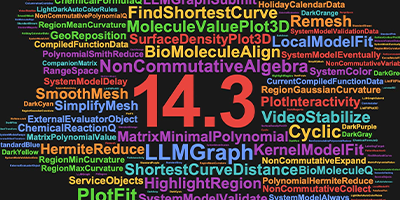Wolfram Demonstrations Project: 10,000 Apps Strong
Today we’re excited to announce that the Wolfram Demonstrations Project has crossed the 10,000 Demonstrations mark and is now supporting the latest versions of the Wolfram Language and CDF Player. Launched in 2007, the Demonstrations Project is the largest open web repository of peer-reviewed interactive knowledge apps. With examples ranging from elementary math to medical image processing, the site fulfills a need for professionally vetted, sophisticated, and easy-to-use resources for students, educators, publishers, and anyone looking to communicate technical concepts with graphic clarity.
Since we began publishing Demonstrations, nearly 28 million different people have visited the site. We thank our 2,039 contributors (including Stephen Wolfram himself)—and especially the 1,961 independent authors ranging from high school participants of our Mathematica Summer Camp to Ivy League professors to real estate aficionados—for their creativity, ingenuity, and dedication. These contributors have made interactive models including rotary engines, Enigma machines, optical illusions, photographic filters, and planetary systems that have been used to create or enhance public information resources, interactive textbooks, journal articles, course websites, and even legislative testimony.
Not surprisingly, Demonstrations have had the greatest impact in education. With the surge of 1:1 initiatives and flipped classrooms, the need for engaging, readily available curriculum resources is greater than ever. We often hear from instructors about how the dynamic visualization features of Demonstrations help students explore and understand hard concepts that are nearly impossible to grasp when viewed only as static pictures.
It is also rewarding to see users become contributors, using the open code of existing examples as a jumping off point to create their own submissions, or starting from scratch to create a new Demonstration with just a few short lines of code.
The Wolfram Language function Manipulate and the Computable Document Format (CDF) form the backbone of the Demonstrations Project. Manipulate automates the process of making interactive interfaces with controls such as sliders and radio buttons, while the functions it can call to compute data and create graphics and text span the whole range of the Wolfram Language, for example, this Plot expression:
![Plot[Sin[2 x] Plot[Sin[2 x]](https://content.wolfram.com/sites/39/2015/03/PlotSin2-x.png)
Replace constants with variables; specify the ranges of the variables, and the result is an instant interface:
![Manipulate[Plot[Sin[ax] Manipulate[Plot[Sin[ax]](https://content.wolfram.com/sites/39/2015/03/ManipulatePlotSina-x-x-0-6-a110-1.png)
Once saved as CDF, the free CDF Player makes that content readily accessible to anyone, increasing the reach of the Demonstrations Project to literally global proportions and spurring the growth of active communities around it.
With the release of Mathematica 10, users are able to expand the Demonstrations repertoire even further with new and powerful functions. We added a host of new areas, including machine learning, computational geometry, geographic computation, and more. With last month’s release of a CDF Player that also supports these features, the entire Demonstrations community can now benefit, and we are now officially accepting Version 10–based submissions (like the example below that uses new mesh regions functionality).
Because browser plugins won’t be around forever, we’re also working on transitioning Demonstrations into CDFs that run in the cloud with HTML5, no plugin required. Last year we released two extraordinary cloud environments for programming that are making this possible: Mathematica Online and Wolfram Programming Cloud.
Are you ready to submit your own Demonstration? Check out these resources:
• General tips and hints for authors are available on the Author Guidelines page
• Explore the basics of the Manipulate function in this training video
• Learn Wolfram Language basics for Interactive Manipulation
• Collaborate with others on Wolfram Community
We’re excited to see what new Demonstrations are yet to come. Author a new Demonstration today and help make knowledge accessible for everyone!




Hi, As an aid to writing a book about systems I’ve just been trying two “demos”, one is called Double Pendulum the other is Restricted 3 Body Problem in 3D. Re the former the movement becomes very jerky and useless after about 10 seconds. Also is there any way to set how long the trace persists? I sometimes want to see the last few seconds, other times I would like it to last much longer. Finally, are there any more features. For instance having scales for the lower plot. The latter needs more explanation.
Thank you for your comment. The Wolfram Demonstrations Project is a code gallery that is open for submissions from any Mathematica or Wolfram Language user. If you would like, you can download the source code from individual Demonstrations and modify it to fit your needs. For more information about the Deomnstartions please visit the About page.